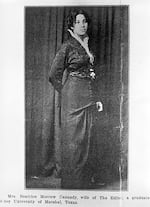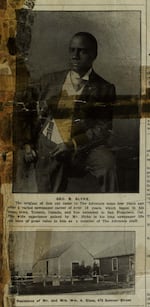On Sept. 5, 1903, the independent Black-owned newspaper “The Advocate” began publication in Portland. Over the next three decades, it would become a powerful voice against racism, taking on the Ku Klux Klan in scathing editorials and challenging discriminatory practices.

FILE - 'The Advocate' newspaper clipping dated June 9, 1923.
Courtesy of University of Oregon Libraries, Historic Oregon Newspapers
At the time, other Black newspapers operated in Portland, but “The Advocate” grew to one of the largest and longest running.
“— "The Advocate" mottoAn independent paper devoted to the interests of the people.”
Beatrice Morrow Cannady, a pioneering journalist
Initially established in Portland by a group of local Black men, co-founder Edward D. Cannady ended up shouldering most of the publishing and editing responsibilities. For nearly a decade he struggled to keep the paper afloat until his new wife, Beatrice, stepped in as assistant editor. She remained the driving force behind the newspaper for the next quarter of a century.

In this image from 1913, Beatrice Morrow Cannady poses for a portrait published in "The Advocate" newspaper.
Courtesy of the University of Oregon Libraries, Historic Oregon Newspapers
Born in Texas in 1889, Beatrice Morrow Cannady relocated to Portland and married Edward Cannady in 1912. Almost immediately, she took over most of the paper’s daily responsibilities. When the couple divorced in 1930, Beatrice gained ownership, becoming publisher and editor of the paper.
On top of all of her work on the newspaper, Beatrice became an active force within the local community. She helped establish the Portland chapter of the National Association for the Advancement of Colored People, going on to be vice president of the local office. She also attended the Northwestern College of Law, now Lewis & Clark Law School, becoming the first Black woman to graduate from law school in Oregon.
The Advocate challenges the Klan
Under Beatrice’s direction, “The Advocate” tackled social injustice head on.
When the editor of a Grants Pass newspaper published a racist article calling the city a “white man’s town,” Beatrice responded with “it is obvious the article is the child of a twisted and dwarfed brain, or the braying of a jackass.”
Throughout the 1920s, the newspaper regularly reported on the growing Ku Klux Klan movement.
“— "The Advocate" promotional advertisement, 1925The only newspaper in Oregon that can be depended upon to fight the battles peculiar to ‘The Race.’”
A front page article from June 9, 1923, detailed a near lynching of a local Black man by KKK members: “Six white robed men, masked, five of them with white hoods and the sixth with one of red, were in the lynching party… a noose was placed around Ellis’ neck and the end of the rope was thrown over the limb of a tree.”
Another article in October of that year reported that two Black men were run out of Klamath Falls by the Klan, adding “it is also said that all colored people in the town who own pleasure cars have been ordered to leave town.”
For years, it fought to stop screenings of the popular D.W. Griffith’s racist film “Birth of a Nation.” An article from Feb. 23, 1924, stated, “The exhibition of such a picture could have no other motive than to stir up hate.”

This 1913 clipping from 'The Advocate' shows newspaper employee George B. Slyke, and the residence of Mr. and Mrs. William A. Glass.
Courtesy of University of Oregon Libraries, Historic Oregon Newspapers
Empowering Black Oregonians
The newspaper’s pages also documented the lives of Black Oregon residents. It included biographies of locals and featured stories highlighting businesses and families, such as this portrait of “The Advocate” employee George Slyke, and an image of the home of Mr. and Mrs. William A. Glass in Portland.
There were also birth and wedding announcements, obituaries and general society news celebrating events in the community.
Advertisers included white businesses courting Black customers. A Meyer & Frank Company advertisement from 1913 included the messages, “To serve all of the people all of the time” and “a store for all men.”
Three decades of advocacy
During the Great Depression, the newspaper struggled, and Beatrice began running “The Advocate” out of her Portland home while still keeping busy in the community. She worked for school integration and lobbied the Oregon Legislation for broader civil rights laws.
In 1932, the now remarried Beatrice ran for the Oregon Legislature, representing Multnomah County. In an article published on April 2, she said: “I shall support all honest, sane legislation designed to improve the general condition of our state and which will improve the economic and social welfare of its people.”
Though she lost the race, she gained 7,000 votes — far more than the Black population of her district. The 1930 census counted fewer than 2,000 Black residents in the Portland area.

This 1932 clipping from "The Advocate" shows an advertisement for State Representative candidate Beatrice Cannady-Franklin.
Courtesy of University of Oregon Libraries, Historic Oregon Newspapers
After three decades of publication, the newspaper finally closed in the late 1930s when Beatrice moved to Los Angeles to be closer to her grown children. She died there in 1974.
Today, some issues of “The Advocate” are available online through the University of Oregon’s Historic Oregon Newspapers and the Portland State University Library’s online portal PDXScholar Access For All.
Oregon Experience - Beatrice Morrow Cannady
The documentary “Oregon Experience” delves into the life and work of early activist and civil rights leader Beatrice Morrow Cannady.
